Bonsai trees symbolize so much more than just small plants—they’re like living pieces of art brimming with stories about resilience and beauty! When you see a twisted trunk or delicate leaves, think about the patience and dedication it took to shape them.
Terms like “jins” and “sharis” are part of the bonsai lingo that connect enthusiasts in this fascinating culture. Isn’t it intriguing how they encapsulate life’s journey?
Stick around, and you’ll uncover more about this enchanting tradition! You even can download our free ebook about bonsai symbolism!
Quick Takeaways
- Bonsai trees symbolize resilience and endurance, showcasing strength through their twisted trunks despite constraints and challenges in growth.
- They represent balance, harmony, and patience, reflecting deep cultural narratives intertwined with nature and spiritual practices.
- Bonsai embodies the impermanence of life, illustrating beauty in transient moments and the acceptance of change.
- The cultivation of bonsai fosters a mindful connection to nature, promoting inner peace and personal growth through artistic expression.
- Gifting bonsai trees signifies emotional connections and shared moments, making them meaningful tokens of heritage and relationships.
Bonsai Tree Symbolism
In the world of bonsai, these tiny trees hold a treasure trove of meaning that transcends their delicate appearance.
Each bonsai connects us to nature’s beauty through stunning miniature vistas, showcasing our artistic expression.
Don’t you love that rush of pride when you nurture a tree using traditional techniques?
The emotional connection forms a bond, providing therapeutic benefits that promote sustainability and nature therapy, while the botanical diversity reflects cultural heritage, enriching our lives in unexpected ways. The bonsai is renowned for its spiritual significance, symbolizing protection and resilience in many cultures.
Download our ebook about Bonsai Tree Symbolism
You can download the brand new Silent Balance ebook “The Art of Bonsai Symbolism” for free!
Leslie Szabo’s The Art of Bonsai Symbolism (2025) is a meticulously crafted eBook that serves as both an inspiring guide and a rich cultural exploration into the deep symbolic meanings woven into the practice of bonsai cultivation. With just under 110 pages, Szabo takes readers on an enlightening journey that transcends mere horticulture, highlighting bonsai as a living art form infused with spiritual, philosophical, and cultural significance.
The book opens with an engaging introduction to bonsai’s artistic foundations, contextualizing it within its ancient Asian origins and spiritual roots. Szabo skillfully unpacks how bonsai goes beyond aesthetics, serving as a medium for expressing harmony, balance, and interconnectedness with nature—themes that resonate throughout the volume.
A key strength of this work lies in its comprehensive approach to symbolism. Szabo elucidates core symbolic principles, such as the emotive storytelling conveyed through bonsai composition and the personalization of meaning by caretakers. The in-depth discussion of spiritual dimensions—covering Zen Buddhism, Wabi-Sabi, Daoism, and mindfulness—integrates bonsai with broader Eastern philosophies, revealing how each tree reflects not only natural cycles but also inner human journeys.
The eBook excels in detailing symbolism specific to tree species and classic bonsai styles. Here, one finds poetic meanings assigned to pines, maples, and more, alongside interpretations of iconic shapes like the Upright, Cascade, and Literati styles. These chapters offer practical insights for readers wishing to select or style bonsai with intention rooted in tradition and narrative.
Beyond the living plants themselves, Szabo’s exploration of structural elements—such as trunks, deadwood, roots, and pots—as symbolic components adds intriguing layers to understanding bonsai. The addition of moss, rocks, water features, and miniature figurines as part of symbolic composition enriches the reader’s appreciation of how every element contributes to the overall story a bonsai tells.
Culturally, the book provides a thoughtful survey of bonsai symbolism across Asian traditions and its evolution into Korean, Japanese, and Western contexts. This global perspective highlights both continuity and innovation in symbolic interpretations, underscoring bonsai’s universal appeal as an artistic expression.
The latter sections offer practical guidance that aligns symbolic philosophy with everyday practice—integrating bonsai into home decor, Feng Shui, and personalized artistic expression, as well as detailed care instructions to sustain the trees’ vitality and symbolic resonance over time.
In summary, The Art of Bonsai Symbolism is a definitive ebook resource for bonsai enthusiasts, spiritual seekers, and art lovers alike. Leslie Szabo’s scholarly yet accessible narrative enriches understanding of bonsai as an evocative art form that embodies nature, culture, and the human spirit. This eBook is ideal for readers who want to deepen their connection to bonsai’s timeless symbolism and nurture their own living miniature masterpieces with mindful intent.
The Origin of Bonsai Symbolism
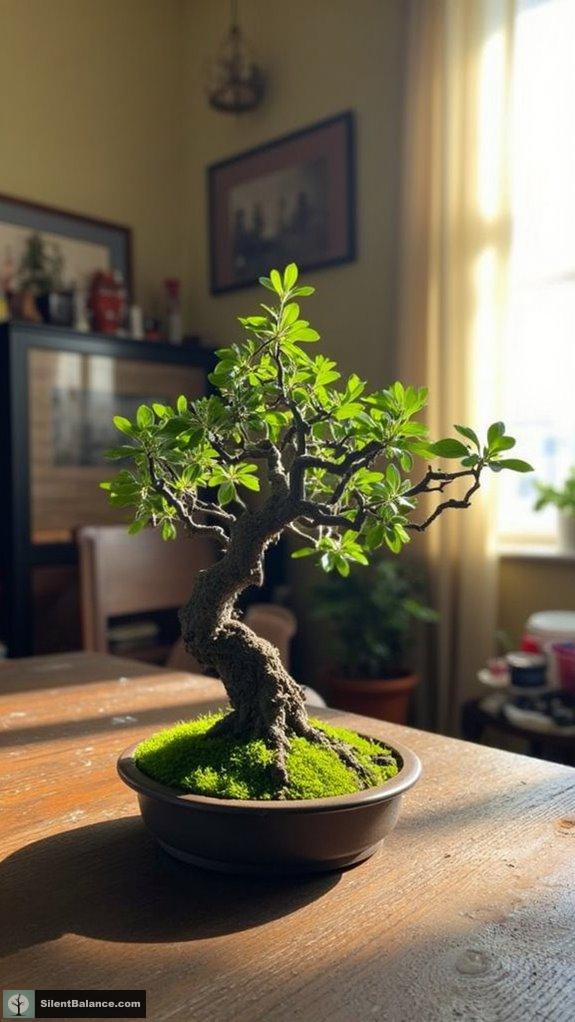
When you start diving into the world of bonsai, it’s easy to get swept away by its rich history and profound symbolism.
The origin of bonsai symbolism stems from ancient traditions, where each tree conveys a unique story or message.
Ever wonder why a twisted trunk signifies resilience?
It’s because bonsai is more than just art; it’s a dialogue with nature, symbolizing balance, harmony, and patience.
As you explore, you’ll uncover symbolic meanings that resonate deeply—like how a tree’s age reflects wisdom. Additionally, the design choices in bonsai, such as popular bonsai styles, illustrate the connection between culture and natur
Tree Symbolism
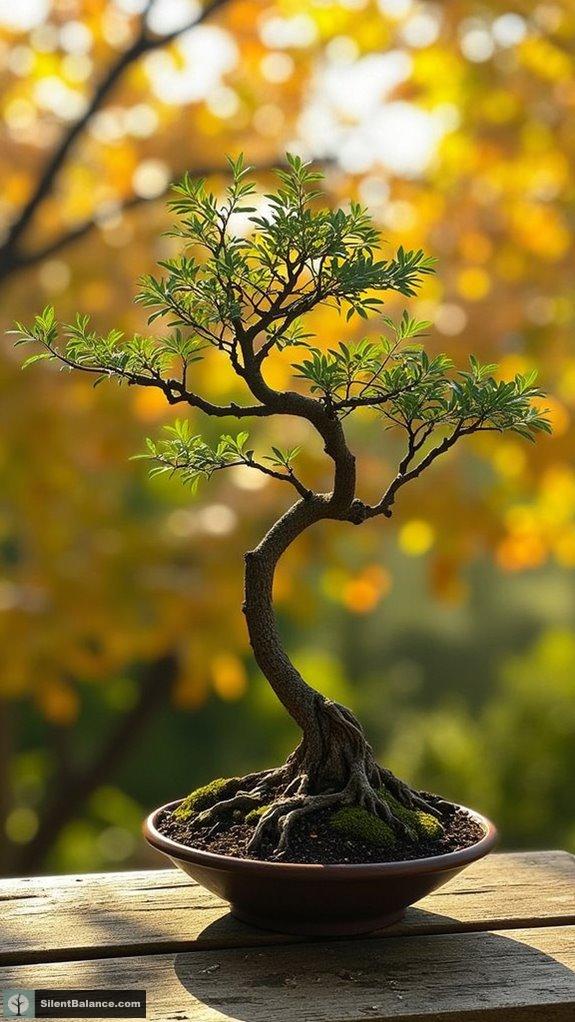
Trees themselves have a remarkable depth of symbolism, rooted not only in various cultures but also in our personal experiences.
Their meanings unfold through:
- Growth stages, representing life’s phases
- Color significance, setting the mood for our emotions
- Ecological impact, highlighting our connection to nature
As I ponder tree symbolism, I recognize how seasonal changes reflect our inner lives, while cultural interpretations offer a rich tapestry of beliefs.
The emotional resonance of trees evokes philosophical implications and inspires artistic expression. Additionally, the Tree of Life symbolizes both physical and spiritual immortality, intertwining our existence with the concept of eternal growth.
Isn’t it fascinating how each design element can tell a story, binding us to a larger narrative of existence?
Cultural Significance of Bonsai Trees
As you explore deeper into the world of bonsai, you’ll discover that these miniature trees carry cultural significance beyond their delicate appearance.
Bonsai embodies rich cultural narratives, showcasing unique botanical heritage. They’re not just plants; they’re artistic expressions shaped by meaningful traditions and historical influences.
Ever consider how bonsai intertwines with spiritual practices? Each tree symbolizes life’s journey and resilience, creating community connections.
Plus, think about their environmental significance—tiny ecosystems thriving in pots!
From a global viewpoint, bonsai reflects diverse philosophies and values. Isn’t it fascinating how symbolic art in a small form can have such a big impact? Additionally, the care involved in nurturing bonsai requires a dedicated fertilizing schedule, which emphasizes the commitment involved in this art form.
Bonsai as a Representation of Nature
While exploring the enchanting world of bonsai, you can’t help but notice how these miniature trees serve as a stunning representation of nature’s grandeur.
Think of each bonsai as a nature depiction—a living art that captures life’s essence in the palm of your hand.
They’re not just cute; they’re a miniature ecosystem, fostering a unique nature connection.
Isn’t it fascinating how these tiny trees encapsulate life, reminding us of the delicate balance in our own environments?
Through their complex branches and tiny leaves, they provide environmental representation, urging us to reflect on our role within nature’s vast tapestry.
Moreover, bonsai can also embody spiritual significance, offering a deeper understanding of our connection to the universe and nature.
The Art of Bonsai and Its Symbolic Meaning
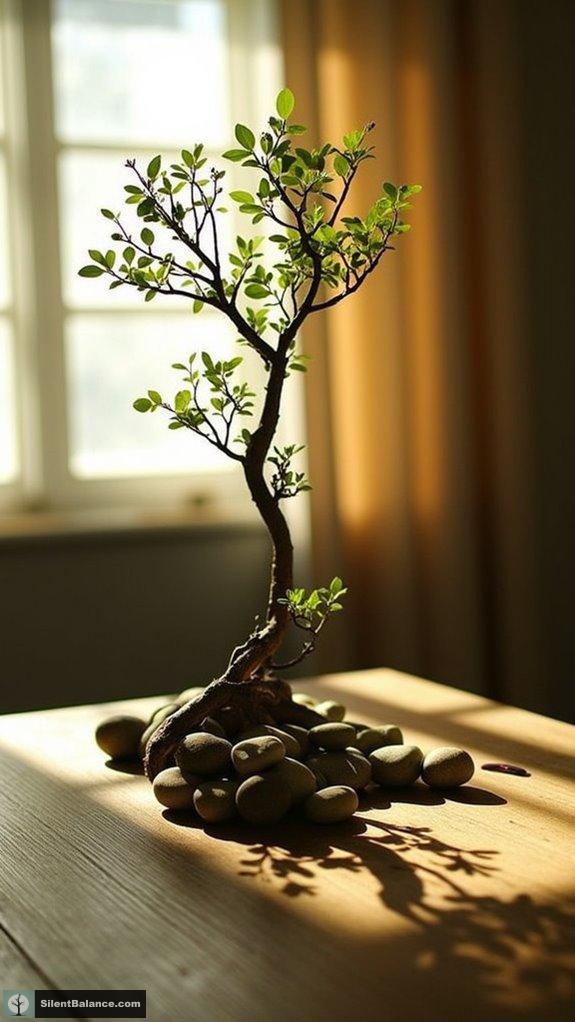
Bonsai isn’t just about shaping a tree; it’s a harmonious dance between art and nature, with each twist of the branch telling a story.
Through artistic expressions and symbolic methods, I find emotional connections deepen as I cultivate my miniature masterpiece. Each pruning and wiring technique reflects not only bonsai aesthetics, but also my personal reflections on life.
With nature’s influence guiding my journey, I’ve incorporated mindfulness exercises and spiritual practices into my routine. By embracing cultural practices, I channel my creativity and control, transforming my bonsai into a living representation of patience and artistry. The spiritual significance of ancient bonsai adds depth to our understanding of these tiny trees.
Isn’t it amazing how a small tree can hold such significance?
Patience and Dedication in Bonsai Cultivation
Cultivating a bonsai is a journey that demands an incredible amount of patience and dedication.
Have you ever mastered pruning techniques? They’re essential for guiding your tree’s artistic expression. Each snip reveals growth milestones, letting your bonsai reflect seasonal changes.
Sure, there are cultivation challenges—pests, weather, and sometimes, your own impatience. But through patience practices, you’ll find dedication rewards in the nurturing process.
Engaging with your bonsai isn’t just about care; it’s an emotional investment. It’s mindfulness in action, creating a bond with your miniature masterpiece.
Bonsai Trees in Japanese Culture
In Japan, where bonsai trees aren’t just plants but revered art forms, you’ll find rich symbolism interwoven into daily life.
These incredible miniatures capture the essence of nature through:
- Bonsai rituals that reflect daily mindfulness
- Bonsai festivals celebrating craftsmanship and culture
- Bonsai exhibitions showcasing stunning aesthetics
The bonsai philosophy encourages patience and control, weaving together a community of enthusiasts. This practice aligns closely with Buddhist symbolism that emphasizes harmony and balance in life.
In workshops, you learn essential techniques while sharing stories and values.
Isn’t it fascinating how these tiny trees can embody such profound meanings?
Let’s dig deeper into the lush world of bonsai symbolism together!
The Role of Size in Bonsai Symbolism
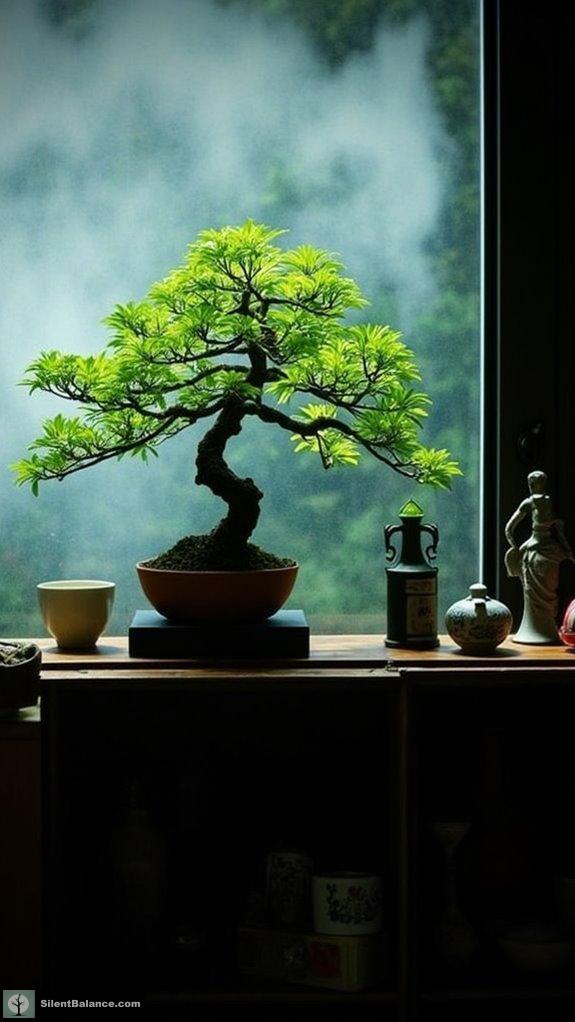
When it comes to bonsai trees, size really does matter—believe me!
The miniature representation of nature through these compact growth wonders adds a unique dimension to size symbolism.
Don’t you love how size perception can shift when you see a tiny tree dominating its space?
Dwarf varieties create striking size contrast with their surroundings, enhancing their proportional impact and visual hierarchy.
Embracing tiny aesthetics, bonsai artists harness the symbolic scale of these plants, showcasing strength in small frames.
It’s like nature’s gentle reminder that greatness can come in the smallest packages, right?
Harmony and Balance in Bonsai Design
While many think of bonsai as just a tiny tree, it’s really about the exquisite dance of harmony and balance that these miniature wonders bring to life.
I’ve come to realize that achieving aesthetic harmony involves meticulous attention to detail, leading to a stunning design equilibrium.
Key elements I focus on include:
- Minimalist balance in every branch
- Natural symmetry that flows effortlessly
- An earth connection that grounds the viewer
Capturing visual proportion in bonsai can feel like a delightful challenge, don’t you think? This art form embodies symbolism in minimalist living, allowing us to appreciate simplicity in our surroundings.
With patience and practice, we can create a world of perfect symmetry right at our fingertips!
Bonsai as a Metaphor for Life’s Journey
Bonsai really embodies the twists and turns of life’s journey, wouldn’t you agree?
Each tiny tree reflects our personal growth, shaped by life challenges and moments of journey reflection.
Isn’t it amazing how nurturing a bonsai teaches lessons in resilience?
As we overcome obstacles, we find our own cultivation journey, balancing life’s complexities with patience.
It’s a transformative process—just like wiring a branch, sometimes we need to give ourselves a gentle nudge.
With every cut, we gain wisdom, learning to embrace imperfections.
Additionally, the practice of bonsai encourages mindfulness and presence, highlighting the importance of living in the moment.
Resilience and Endurance Depicted by Bonsai
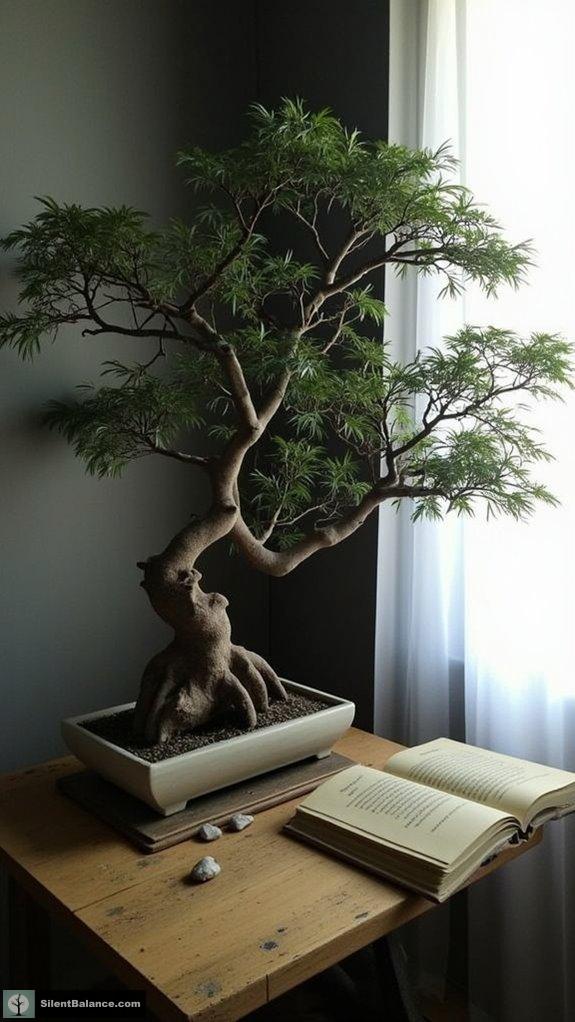
In the world of bonsai, you can’t help but appreciate how these miniature marvels embody resilience and endurance. Their tiny trunks twist and turn, showcasing strength through adversity. Isn’t it fascinating how they thrive despite constraints?
I marvel at their ability to flourish, demonstrating:
- Adaptability in confined spaces
- Remarkable longevity over decades
- Complex aesthetics born from tough conditions
Each bonsai tells a story of miniature growth battling nature’s challenges. This reminds us that, like these trees, we can also learn to endure and thrive, no matter how rocky the path. Furthermore, Buddhist meditation practices often incorporate these trees, as they symbolize patience and mindfulness in the face of life’s obstacles.
After all, who doesn’t love a bit of cute tenacity?
Spiritual Meaning of Bonsai Trees
Ah, the enchanting world of bonsai trees!
These miniature marvels aren’t just eye candy; they’re pathways to inner peace and spiritual growth. As I nurture my bonsai, I discover a meditative rhythm, each snip and twist fostering my connection to nature.
Have you ever felt the calm washing over you while tending to one? Bonsai culture is rich with terms like “jins” and “sharis,” adding a unique flavor to our shared passion.
Through careful cultivation, I learn patience, control, and resilience. Each bonsai embodies my journey, reflecting my spirit, and reminding me that beauty lies in the details—small yet profound.
Bonsai and the Concept of Impermanence
Life’s fleeting moments are beautifully captured in the art of bonsai, where each tree tells a story of growth and decay.
I’m often reminded of the hurried yet mindful presence we experience in life as we reflect on these elegant specimens.
Consider the charm of bonsai’s impermanence:
- Embrace the ephemeral beauty of each twist and leaf.
- Recognize the bittersweet changes that come with time’s passage.
- Appreciate nature’s cycles that teach us acceptance of transformation.
These miniature masterpieces whisper secrets of life fragility, revealing unique viewpoints on growth impermanence, and reminding us to savor each precious moment. The philosophy of Buddhism’s concept of impermanence encourages us to find peace in the transient nature of existence.
Isn’t that what we’re all after?
The Connection Between Bonsai and Zen Buddhism
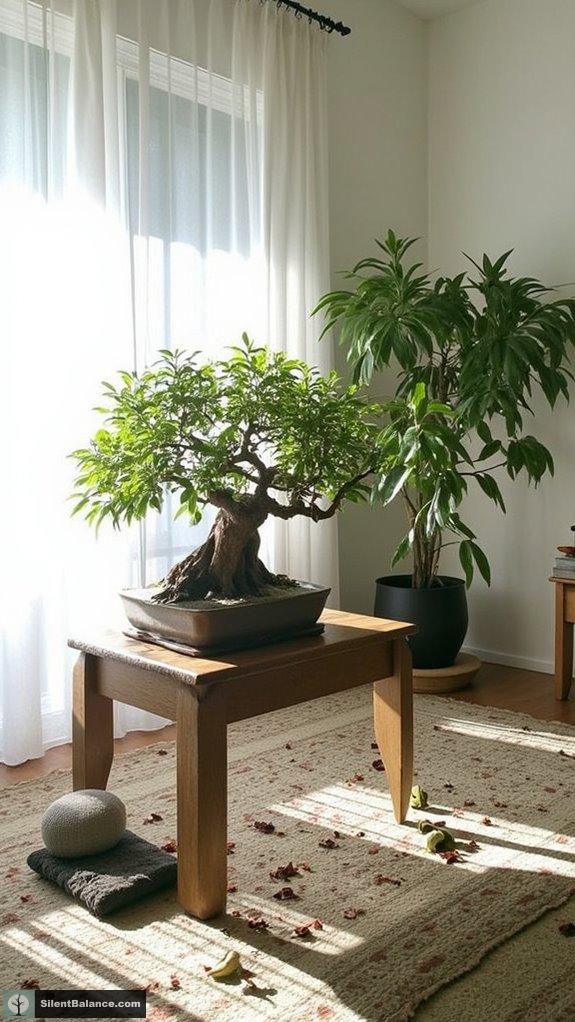
Bonsai isn’t just about shaping trees; it’s a canvas for Zen philosophy wrapped in ancient tradition.
Embracing Zen mindfulness transforms my bonsai practice into something profound. Each snip of the shears isn’t mere pruning; it’s a meditation, connecting me with nature’s rhythm.
Through bonsai aesthetics, I discover visual harmony that nurtures my inner peace.
Isn’t it incredible how mindful cultivation leads to spiritual growth? The tranquility of my bonsai creates a serene environment, enhancing my meditation practices.
This intimate dance between Buddhist philosophy and living art reveals a deeper nature connection I’d never anticipated. Bonsai trees serve as visual representations of impermanence in life, reminding us of the transient beauty inherent in all things.
Who knew tiny trees could hold such power?
Bonsai as a Symbol of Peace and Tranquility
Tranquility often feels elusive in today’s fast-paced world, doesn’t it?
A bonsai tree can transform your space into a haven of peace.
With its miniature size and meticulous care, it promotes:
- Serene vistas that soothe the soul.
- Mindfulness practices to quiet the mind.
- Nature therapy to physically ground us.
Picture a bonsai gracing your desk, reminding you to pause, breathe, and reflect.
It cultivates a peaceful mindset, enhances stress reduction, and nurtures a harmonious existence.
The meditation benefits are undeniable as it encourages inner peace. Additionally, engaging in the cultivating mindfulness process through bonsai techniques fosters a deeper connection to nature.
Embrace the calming settings bonsai creates, inviting tranquility into your life!
Friendship and Relationships Represented by Bonsai
In a world where connections seem fleeting, nurturing friendships can feel like an art form, much like cultivating a bonsai.
Don’t you just love those friendship bonds that thrive with emotional nurturing? They require trust cultivation and mutual respect, just like the careful pruning of a bonsai tree.
When we share growth experiences, we create lasting friendships that stand the test of time.
It’s all about understanding dynamics, right? Deep connections flourish through supportive relationships, transforming life into something truly beautiful.
Just as the significance of pine bonsai enriches Japanese culture, nurturing connections can provide a profound sense of belonging and harmony.
Who knew nurturing connections could be as satisfying as achieving the perfect bonsai shape? Let’s dig deep and grow together!
The Significance of Different Bonsai Species
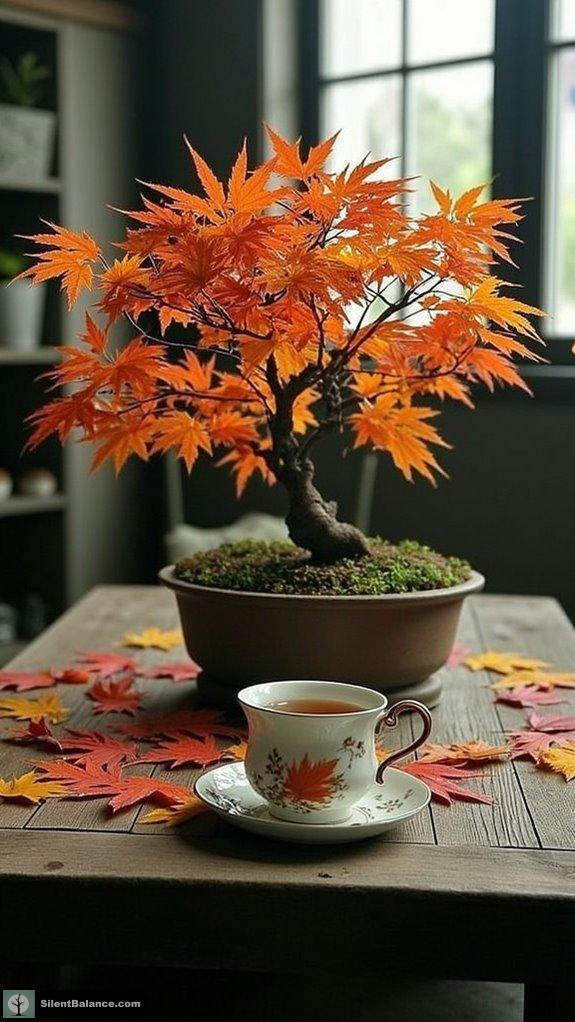
Choosing the right bonsai species can feel like picking your favorite ice cream flavor—so many options, each with its own unique personality!
Here’s a quick guide to some popular bonsai varieties:
- Pine: Known for its enduring strength and resilience, embodying pine symbolism.
- Maple: Celebrated for stunning autumn colors, representing change with deep maple significance.
- Cherry Blossom: Symbolizes transient beauty; its delicate flowers speak of ephemeral moments.
Each species carries its own charm—like a personality in a tiny pot! Bonsai trees, historically rooted in cultural symbolism, invite you to connect with nature’s artistry.
Which one resonates with your essence? The right choice can truly elevate your bonsai journey.
Bonsai as a Gift and Its Symbolic Implications
When you think about giving a gift that reflects thoughtfulness and significance, how often do bonsai trees come to mind?
In the rich gift culture surrounding bonsai, these trees aren’t just plants; they’re nature’s embodiment of relationship dynamics and emotional connections. Gift-giving with a bonsai is an appreciation gesture that conveys personal significance.
Those elaborate symbolic meanings of bonsai resonate deeply, making them a standout among thoughtful presents.
Picture gifting a companion a miniature forest, each twist in the trunk symbolizing shared moments. Isn’t that a delightful way to nurture bonds? Plus, you’ll sound like a bonsai expert—how cool is that? Furthermore, the practice of cultivating a bonsai encompasses embracing serenity, which adds a layer of tranquility to the gift.
Growth and Transformation in Bonsai Trees
Bonsai trees aren’t just symbols of serenity and balance; they embody the essence of growth and transformation.
They represent our personal development and the inner strength we cultivate over time.
- Visual growth reflects our journey.
- Metaphorical roots symbolize stability.
- Resilience training fosters life balance.
As I nurture my bonsai, I realize it mirrors my own transformative journey, teaching me to embrace each twist and turn.
Don’t you feel empowered when you witness the meticulous shaping of a tree?
Each branch’s growth reminds me that nurturing growth requires patience, creativity, and an unwavering belief in the beauty of potential. The practice of bonsai meditation enhances our understanding of inner peace, allowing us to connect deeper with our own growth and transformation.
The Influence of Nature on Bonsai Symbolism
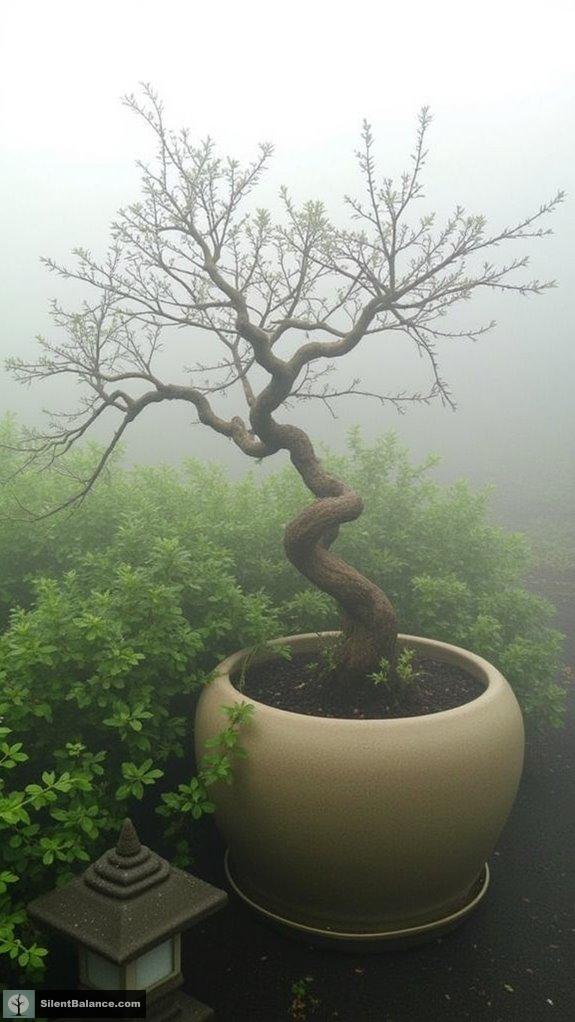
While wandering through a serene garden, it’s hard not to notice how the natural world influences the symbolism behind bonsai trees.
Nature’s beauty speaks volumes, doesn’t it? Each twist and turn of a bonsai captures nature’s resilience and reflects natural harmony.
As you nurture your bonsai, you’re practicing eco-friendly techniques that celebrate sustainable living.
Do you feel that connection?
Who knew that crafting these miniature masterpieces would align so closely with the elements around us?
In the bonsai community, we appreciate the deep meanings behind every leaf and branch, embracing how nature teaches us control and balance in our lives. Additionally, the practice of bonsai is often seen as a reflection of the spiritual meanings in Buddhism, emphasizing mindfulness and inner peace.
Bonsai’s Role in Traditional Japanese Aesthetics
As I explore the world of bonsai, it becomes clear how deeply intertwined this art form is with traditional Japanese aesthetics.
Bonsai exemplifies:
- Aesthetic principles of minimalism and harmony.
- Nature representation in a confined yet expressive form.
- A spiritual practice that reflects seasonal changes.
This artistic expression showcases the cultural roots of Japan, inviting me into a world where visual harmony reigns.
The meditative qualities of bonsai encourage me to appreciate the beauty in simplicity.
Isn’t it fascinating how a tiny tree can embody the vastness of nature?
Bonsai truly transforms our understanding of beauty and control in design, doesn’t it?
Moreover, the practice of bonsai is considered a timeless symbolism across various cultures, illustrating the universal connection between humans and nature.
The Beauty of Simplicity in Bonsai
When you take a moment to appreciate bonsai, you quickly realize how its beauty lies in the art of simplicity.
With its minimalist design, every tree showcases natural elegance and tranquil aesthetics, creating serene vistas that invite contemplation.
I’m fascinated by the complex detailing—each twist and turn revealing a gentle growth that speaks to a balanced composition.
Isn’t it remarkable how bonsai serves as both artistic expression and a personal journey?
Through contemplative practices, we learn to savor time and discover joy in the smallest details.
In a world full of chaos, bonsai’s simplicity truly feels like a refreshing change, don’t you think? Moreover, the philosophy surrounding bonsai emphasizes the journey of growth, highlighting how each tree mirrors the human experience.
Bonsai as an Expression of Personal Philosophy
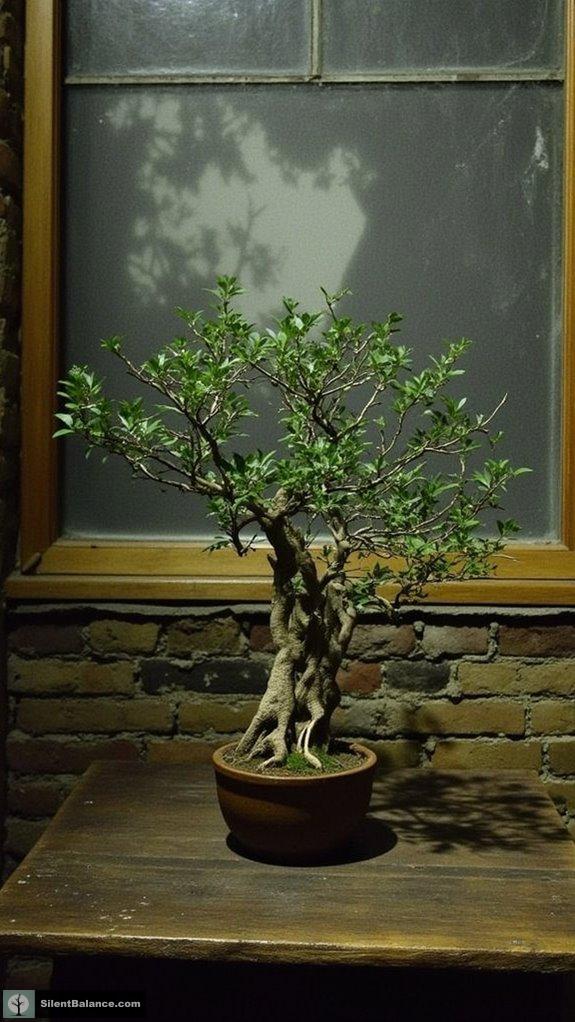
Bonsai isn’t just about shaping a miniature tree; it’s a profound expression of personal philosophy.
Through this art, I find a space for:
- Bonsai mindfulness: Immersing myself in the moment.
- Cultivating patience: Learning to nurture, not rush.
- Artistic expression: Crafting my unique representation of nature.
As I reflect, I embrace a nurturing mindset, balancing challenges with emotional connections.
Isn’t it fascinating how shaping a tiny tree can lead to immense personal growth?
With each twist and turn, I explore philosophical reflection and appreciate nature’s beauty. Ancient bonsai practices help deepen this mindfulness journey.
Bonsai becomes my canvas, where creative freedom thrives!
The Symbolism of Roots in Bonsai Trees
Roots play an essential role in the artistry of bonsai, serving as the very foundation of these miniature masterpieces.
Imagine the root strength, providing a grounding connection that embodies stability and growth. These unseen foundations are a nourishment source, working diligently to support the tree’s life.
Isn’t it fascinating how roots create an interconnection network beneath the surface? They represent a resilience base, adapting to their environment while showcasing depth significance.
Here’s a thought: without them, would bonsai even survive? The environmental impact of strong roots is profound, reminding us that just beneath the surface, life support thrives, enriching our tiny, living sculptures. Additionally, the health of roots is crucial for a bonsai’s cultural significance, as it reflects both the tree’s vitality and the care of its grower.
The Life Cycle of Bonsai and Its Meanings
As you journey through the life cycle of a bonsai tree, you’ll quickly realize that it’s more than just a plant; it’s a living symbol of patience, artistry, and respect for nature.
Consider these key concepts:
- Bonsai growth reflects a meticulous devotion to craft
- Bonsai pruning invites necessary balance and shape
- Bonsai aesthetics transform nature’s quirks into beauty
Embrace bonsai care techniques, respect its history, and watch how its foliage mirrors your effort. Each bonsai style carries its own unique symbolic meanings that reflect the philosophies of its caretakers.
Every trim and twist tells a story of growth and artistry, connecting you to generations of enthusiasts who’ve also wielded the shears. Isn’t that a delight?
Bonsai as a Teaching Tool for Mindfulness
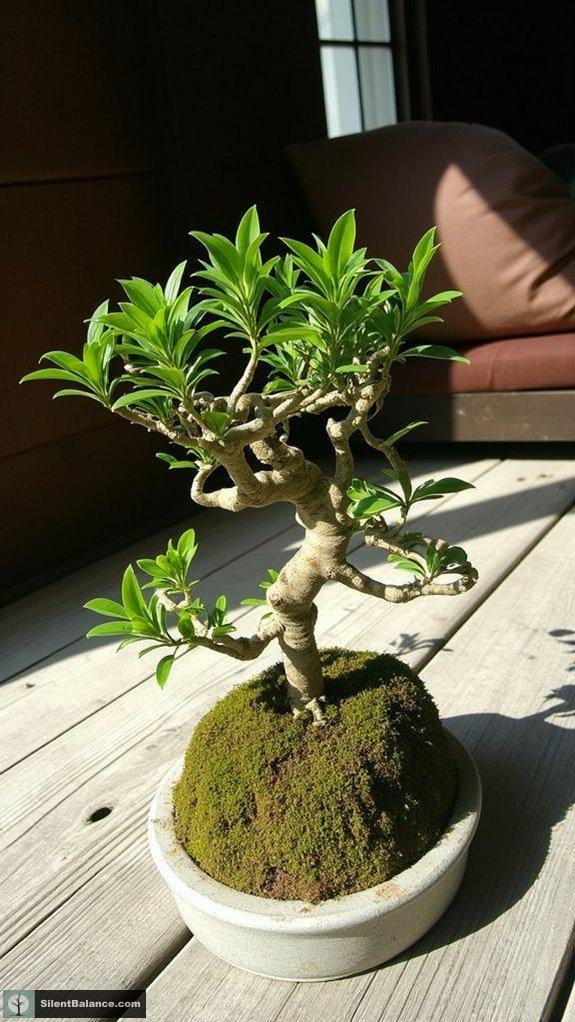
When you immerse yourself in the world of bonsai, you’ll discover an unexpected ally in the pursuit of mindfulness.
Engaging in bonsai meditation is a grounding experience, blending tranquility techniques with focus exercises to cultivate presence.
Ever tried mindful gardening? It’s like tree therapy for the soul!
As you shape these miniature trees, you initiate zen cultivation and develop nature awareness, connecting deeply with your environment.
Why not take a moment to appreciate the complex details of each leaf?
This dance of patience and care sharpens your mindfulness practice, making every snip and twist a step toward serenity.
Additionally, nurturing a bonsai provides a unique opportunity to practice meditative techniques that enhance your overall well-being.
Curious yet? Let’s dig in!
The Essence of Care and Nurturing in Bonsai
Though bonsai might seem like a mere hobby for some, it’s a profound journey filled with care and nurturing that speaks to the heart of what it means to cultivate life.
Through my own experiences, I’ve discovered how essential it’s to immerse myself in this art. It’s a dance of growth and connection, incorporating:
- Mindfulness practices that elevate your awareness
- Maintenance rituals that enhance emotional bonds
- Nurturing techniques that foster personal connections
In this cultivation process, I’ve found nature appreciation wrapped in symbolic gestures, guiding me deeper into my care philosophy and enriching my growth journey. Additionally, understanding the importance of winter care tips can significantly influence the longevity and health of outdoor bonsai trees.
The Transformational Power of Bonsai
Bonsai isn’t just a tree, it’s a tiny universe poised on a desk or in a garden, waiting to transform your mindset.
Embracing a growth mindset is essential, as nature transformation melds with aesthetic evolution right before your eyes. Each miniature scenery thrives with emotional resonation and environmental symbolism, teaching you resilience.
Through mindful cultivation, you engage in silent reflection and artistic expression.
Doesn’t it feel empowering to shape something beautiful while adapting ancient cultural practices? Moreover, nurturing your bonsai parallels the journey of cultivating patience, allowing you to connect deeply with the art of bonsai.
Bonsai in Feng Shui Practices
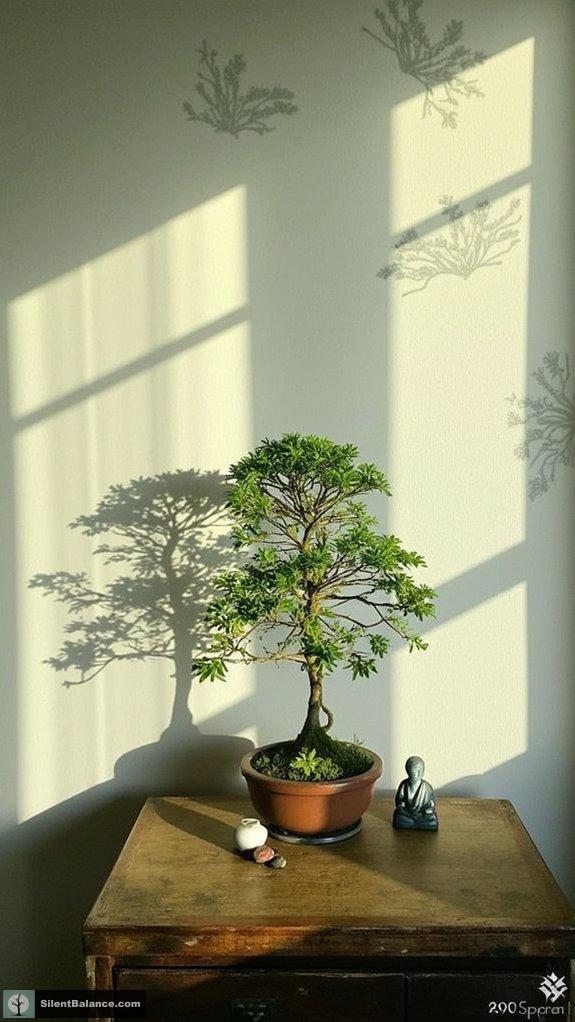
In a world brimming with chaotic energies, placing a bonsai in your home can work wonders for balancing your atmosphere. It’s not just about the plant; it’s about how you harness feng shui principles to create energy flow and spatial balance.
Here’s why you should consider bonsai:
- Aesthetic placement enhances your home’s vibe.
- Protective symbolism brings restorative energy into your space.
- Auspicious positioning boosts plant vitality and harmony alignment.
During dormancy, you should be cautious about fertilizing bonsai to maintain their health and energy flow.
Are you ready to invite natural elements into your life? With a little care, those tiny trees can transform your environment, inviting tranquility and peace.
The Symbol of Strength Offered by Older Bonsai
When I see an older bonsai, I can’t help but feel a deep sense of strength emanating from its twisted branches and gnarled roots.
That old bonsai tells a story of ancient wisdom, a living proof of resilience and enduring roots. Its weathered beauty offers a majestic presence, inviting us to reflect on our own strength representation.
These trees embody timeless power, each knot and curve a reminder of their rooted history.
Do you see the resilience in their growth? That’s the strength symbolism we all crave—an inspiring manifestation of not just survival, but thriving against the odds. Additionally, bonsai trees are often regarded as a representation of cultural significance, reflecting the deep connection between nature and human consciousness.
Bonsai and the Changing Seasons
As the seasons shift, I often find myself captivated by the way these miniature trees respond, showcasing their elegance through an ever-changing tapestry of colors and textures.
Consider these facets of seasonal transformation:
- Seasonal beauty: Each bonsai reflects nature’s rhythm, presenting its unique vibrancy.
- Climate reflections: The environmental impact on these trees illustrates time progression vividly.
- Growth cycles: Embracing seasonal aesthetics, they adapt and thrive, showcasing nature’s cycles.
- Indoor vs outdoor care: Understanding care differences between indoor and outdoor bonsai is essential for their well-being throughout the seasons.
Isn’t it fascinating how bonsai embodies seasonal changes?
Watching these delightful trees navigate the year prompts me to appreciate the delicate balance of life and nurture my own sense of control, too.
Bonsai Trees as Emblems of Hope
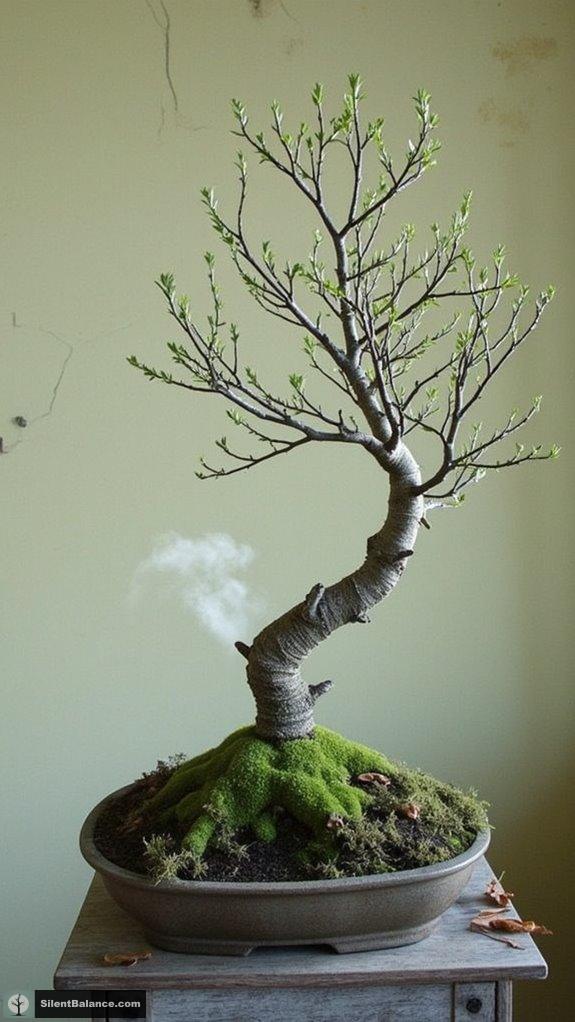
The bonsai world is rich with unique terms, like “shari” (the deadwood that adds character) and “jin” (a style where branches are transformed into striking visuals).
Bonsai hope embodies both resilience and beauty, reminding us that dreams and aspirations can flourish, even in miniature forms.
When I carefully shape my trees, I embrace bonsai perseverance, knowing that growth takes time. Each twist and turn reflects my own journey of renewal, filled with faith.
This intimate process fosters bonsai optimism, inspiring positivity and a sense of adventure.
In nurturing these tiny wonders, I’m nurturing my own journey towards big dreams. Moreover, the mindfulness cultivated through nurturing bonsai trees reflects the Bodhi tree meditation that enhances spiritual connections with nature.
Legacy and Memory Represented Through Bonsai
Though bonsai trees may be small, their ability to carry legacy and memory is nothing short of monumental.
These miniature marvels represent our deepest connections to family and heritage, making them perfect vessels for:
- Emotional ties that bridge generations
- Timeless tributes to beloved ancestors
- Symbolic legacies etched in every branch
With each carefully crafted curve, I can preserve memories and honor my roots.
Bonsai often hold our collective memory, reminding us of enduring relationships and familial bonds. In fact, the intricate details of their design can mirror symbolic tree art that represents familial connections, enriching the meaning behind every leaf and twig.
Isn’t it incredible how a small tree can embody so much? It truly elevates the art of remembrance practices to a whole new level!
Bonsai Trees and the Concept of Minimalism
Bonsai trees offer more than just a glimpse into family legacies; they also embody the beautiful simplicity of minimalism.
When you think of minimalist design, what comes to mind?
For me, it’s about stripping away the excess to reveal beauty in restraint.
With mindful nurturing, each tiny tree becomes a reflection of intentional living, emphasizing what truly matters.
Isn’t it fascinating how a little twist here or a snip there can create dramatic effects?
As you explore this art, you’ll find that every branch and leaf tells its own story—proving that less really is more in our busy, cluttered lives. Additionally, specific bonsai styles highlight the elegance of distinct forms, perfectly aligning with modern minimalistic decor.
The Connection of Bonsai With Land and Heritage
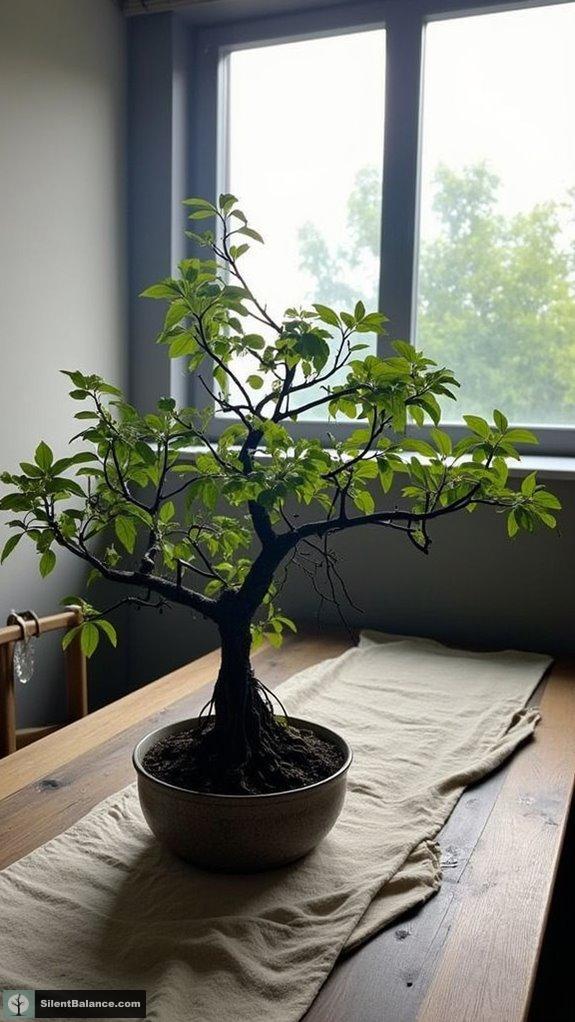
As we explore the world of bonsai, it’s hard not to appreciate how deeply these miniature marvels connect us to the land and the cultural heritage they embody.
Bonsai isn’t just about growing trees; it’s about honoring our roots.
Think about it:
- The meticulous craftsmanship reflects millennia of tradition.
- Each tree embodies a specific region’s unique land heritage.
- Bonsai art speaks to our shared cultural roots.
Additionally, the symbolism of bonsai trees makes them a thoughtful gift that conveys deep meanings tied to one’s cultural identity and appreciation for nature.
Celebrating Milestones With Bonsai
When you think about celebrating life’s milestones, have you ever considered how a bonsai tree can be part of those special moments?
Imagine that bonsai ceremony as you gift a stunning little tree, a living symbol of personal achievements and growth celebrations. These reminder trees stand tall as journey markers, showing your loved ones that their legacy milestones matter.
Family traditions can blossom when you share the joy of nurturing a bonsai, creating a bond that lasts generations. Additionally, much like the Kapok tree in Buddhism, the bonsai reflects the significance of spiritual growth as you nurture and cultivate your relationship with it over time.
Environmental Awareness Through Bonsai Practices
Cultivating a bonsai isn’t just about the artistry and aesthetics; it’s also a fantastic way to promote environmental awareness. By engaging in this gentle form of gardening, I realize I’ve embraced eco-friendly practices that nurture our planet.
- Sustainable cultivation allows me to minimize my environmental impact.
- Biodiversity promotion happens right in my backyard.
- Urban greening connects me to nature like never before.
Through these efforts, I find myself contributing to climate change response and conservation awareness. Furthermore, the practice of bonsai cultivation reflects a connection to nature similar to that of magnolia tree symbolism, highlighting beauty and resilience in a compact form.
Plus, who wouldn’t want a piece of green aesthetics that symbolizes ecological balance? It’s a win-win, really!
Bonsai as a Reflection of Human Emotions
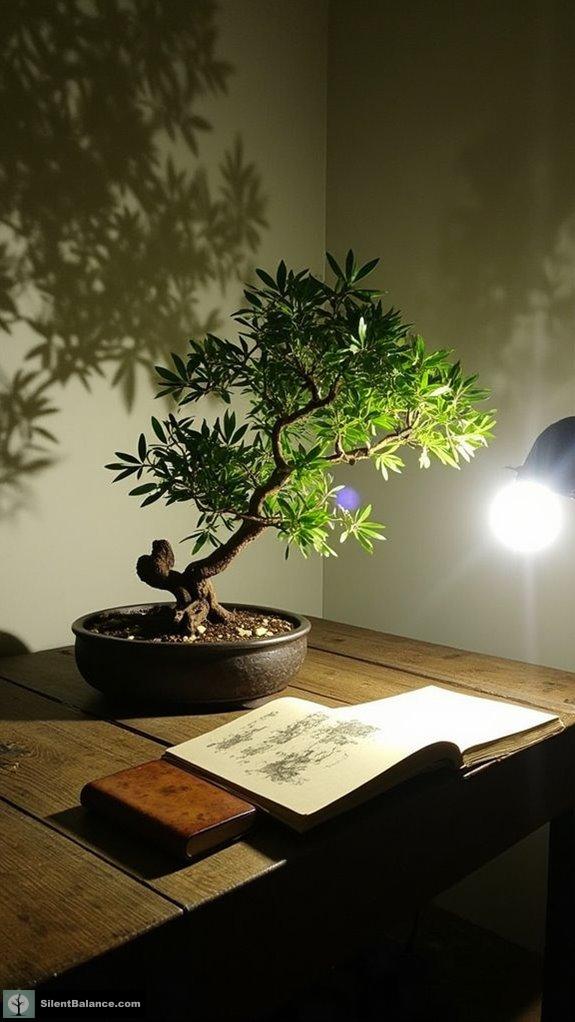
Bonsai trees aren’t just miniature marvels; they’re living embodiments of our emotions, reflecting the ups and downs of the human experience.
Have you ever realized how they capture our emotional expression? Each twist and turn of the branches tells a story of personal growth, echoing our nurturing spirit.
As we cultivate these trees, we engage in a reflective practice that fosters mental clarity and emotional resilience. This spiritual journey is a healing process, guiding us toward inner peace and self-discovery.
Isn’t it fascinating how our artistic vision can shape not just a tree, but also our journey through life?
The Symbol of Protection in Bonsai
In the world of bonsai, one might say that every tiny tree tells a tale of protection. Isn’t it fascinating how these plants embody guardian energy?
- Their nurturing spirit evokes a sense of safety, peace, and tranquility.
- With sheltering branches, they serve as a protective presence in our lives.
- Each bonsai represents ancient wisdom and a life force that promotes sacred growth.
When you nurture one, you create a tangible connection to spiritual guardianship.
Embrace their defense symbolism to achieve a harmonious balance between protection and vulnerability.
Isn’t that a beautiful dance of energy right in your living space?
Moreover, much like mycorrhizal networks, bonsai trees have the ability to communicate and share resources, enhancing their defensive traits against potential threats.
The Balance of Light and Shadow in Bonsai
While you might think of bonsai as merely small trees, they actually reveal a mesmerizing balance of light and shadow that reflects the yin and yang of nature.
In my experience, light contrast creates depth, showcasing exquisite shadow play. It’s in these balance dynamics that we recognize the illumination effects—light symbolizes energy, while shade significance hints at protection.
Have you noticed how a well-placed light source transforms a bonsai, making it almost dance? This enchanting interplay invites us to appreciate each branch’s character, enhancing our connection with nature. Incorporating Japanese bonsai decor can further elevate this experience by creating a harmonious environment that accentuates the beauty of your bonsai.
Bonsai Trees in Western Culture
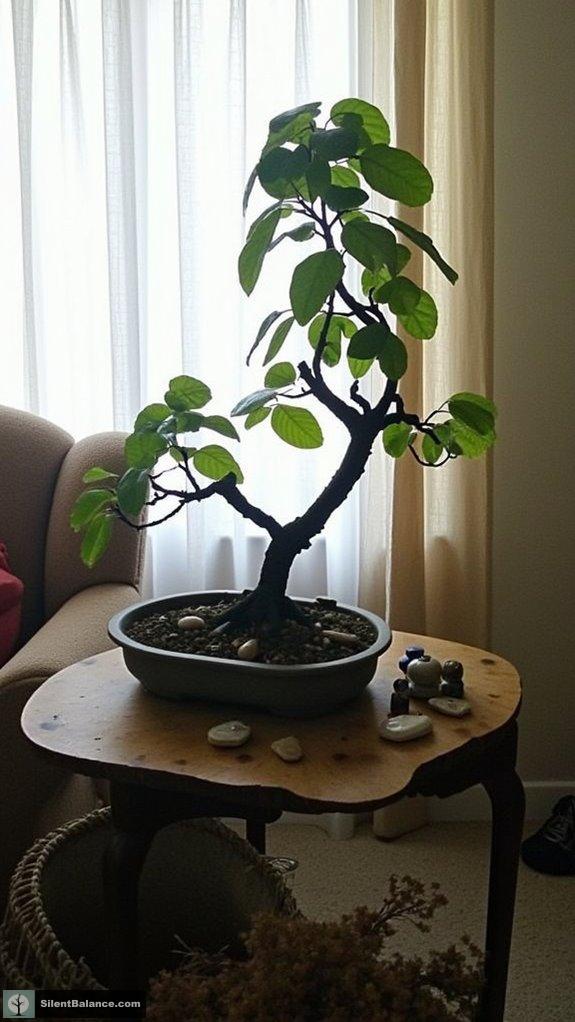
Although many people might associate bonsai primarily with traditional Japanese art, it’s fascinating to see how these miniature masterpieces have taken root in Western culture.
In Western gardening, bonsai brings a unique fusion of zen aesthetics and nature appreciation, creating picturesque miniature settings.
Here are some reasons why bonsai captivates us:
- It reflects a spiritual journey of growth and patience.
- Each tree embodies unique symbolism and artistic expression.
- Bonsai craftsmanship fosters a deeper nature connection.
- The cultivation of bonsai also mirrors the nurturing essence of trees in Buddhism, highlighting the interconnectedness of growth and spirituality.
The Connection Between Bonsai and Art
When I engage in creative cultivation, every snip and twist tells a story, reflecting thoughtful design philosophy. I aim for aesthetic balance and visual harmony, crafting miniature environments that serve as nature inspired art. Each tree becomes a sculptural form, revealing emotional connections between nature’s artistry and my artistic growth. This contemplative practice promotes craft mastery through artistic meditation. It’s rewarding to wield tools that shape conceptual beauty and reveal visual storytelling, where each leaf plays a role in the larger narrative—pure artistic symbolism. Additionally, the cultural significance of bonsai in small spaces emphasizes how these miniature trees represent resilience and harmony within our living environments, creating a balance between nature and design.
Learning From Bonsai: a Life Philosophy
When I explore the world of bonsai, I can’t help but notice how this ancient practice mirrors life itself. It’s all about mindful cultivation and embracing nature’s wisdom.
Here are three important lessons I’ve gathered:
- Nurturing patience: Growth takes time, so don’t rush or force it.
- Emotional resilience: Just like trees, we face storms; it’s how we bounce back that shapes us.
- Simplicity in care: Focusing on the basics can lead to significant developments.
These philosophical understandings foster personal growth, revealing endurance and balance as we navigate life’s transformative process. Bonsai teaches us the value of embracing life’s seasons of change, reminding us that just as trees transition through cycles, so too must we adapt and grow.
Isn’t that beautifully profound?
The Interplay Between Nature and Nurture in Bonsai
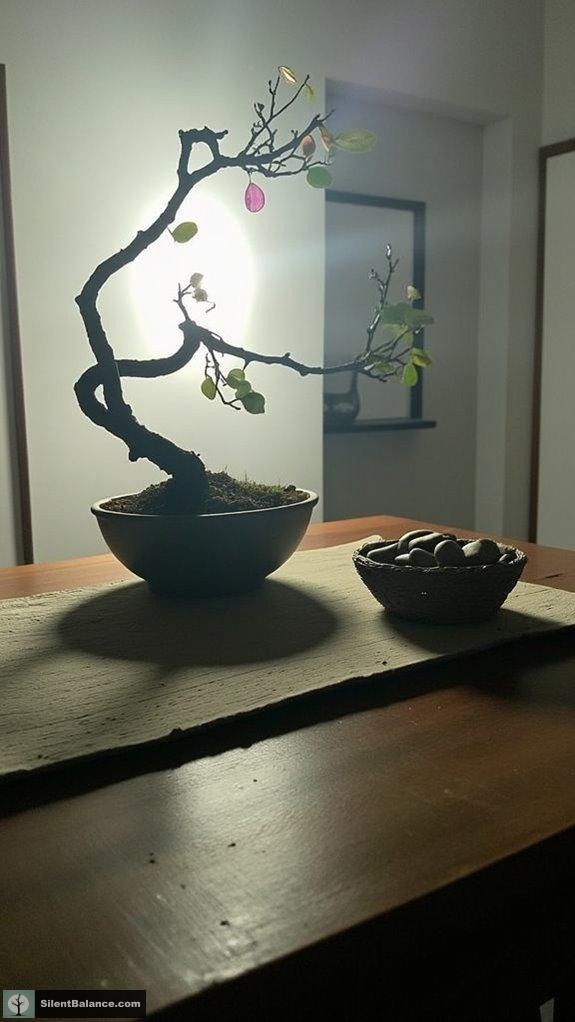
As I plunge into the enchanting world of bonsai, I can’t help but marvel at how nature and nurture intertwine, creating living masterpieces that tell their own stories.
Nature’s resilience shines through in every twist of a trunk, while my nurturing techniques guide each branch’s direction. Achieving growth balance is no easy feat, but it’s thrilling to shape something so alive.
Isn’t it fascinating how artistic expression morphs through spiritual nurturing?
Embracing the elements of bonsai, I connect with fellow enthusiasts, sharing tips like “jin” for deadwood art or “wapf” for that perfect pot. Who knew gardening could be this poetic?
This art form has persisted through adversities, much like the surviving war bonsai that symbolize strength and endurance.
Bonsai as a Symbol of Restoration
Restoration captivates the soul, especially when we consider the bonsai—a living symbol of the beauty of growth after adversity. The bonsai embodies the restoration process, reminding us that even the most twisted branches can find their way back to beauty.
Think about it:
- It teaches patience through a healing journey,
- Each pruning helps reshape the future,
- It celebrates resilience in the smallest forms.
When we nurture a bonsai, we’re not just cultivating a tree; we’re orchestrating a symphony of renewal. Additionally, the bonsai reflects the adaptability of trees, highlighting how they can thrive even in challenging environments.
The Journey of Growth: A Bonsai Perspective
Though bonsai might seem like simply a miniature tree, it holds within its tiny trunk and delicate branches a profoundly rich journey of growth that many of us can relate to.
Consider how each twist and turn in a bonsai reflects our growth journey. Are we growing naturally, or do we sometimes need a little pruning? What about wiring? Just like a bonsai, we shape our lives to direct our paths. Pruning is essential for healthy, balanced growth in bonsai, reminding us that sometimes we must let go to foster our best selves.
With a bonsai viewpoint, every setback becomes an opportunity, and each new leaf symbolizes progress.
The Role of Bonsai in Meditation Practices
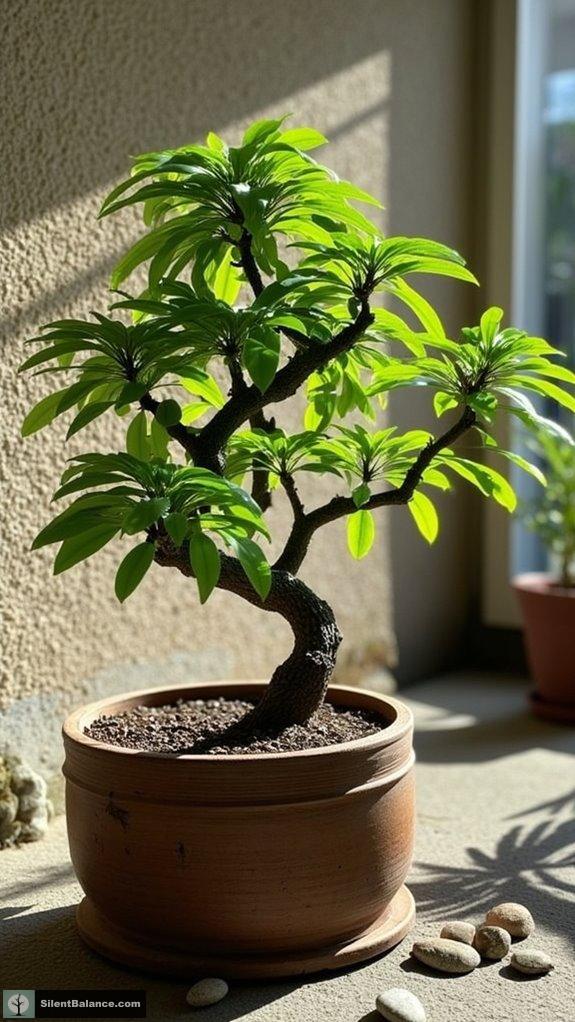
When I immerse myself in the world of bonsai, I discover it’s not just about cultivating miniature trees; it’s about nurturing a mindset geared towards tranquility and focus.
Bonsai creates a
- sacred space that promotes peaceful surroundings.
- nature connection that enhances meditative focus.
- mindful cultivation that encourages intentional breathing.
As I shape each tree, I find inner calmness and spiritual grounding, gaining clarity of thought amidst the hustle. The art of creating bonsai emphasizes the harmony between bonsai and natural stone, which further enriches the meditative experience.
The tranquil presence of bonsai invites me to pause, breathe, and reflect.
Isn’t it incredible how a tiny tree can lead to a vast world of self-discovery and serenity?
Bonsai and Its Symbolic Colors
It’s fascinating how the colors of bonsai can tell their own stories, each hue brimming with meaning and symbolism.
Take green, for instance—it’s the classic choice, symbolizing renewal and hope.
Then you’ve got the fiery red, representing passion and energy, perfect for those fearless spirits.
What about yellow? That one’s a nod to optimism and joy, don’t you think?
Even the sturdy browns carry weight, linking to stability and grounding.
Next time you admire a bonsai, recall the symbolic colors at play—each one whispering unique color meanings that reflect your journey, ambitions, and feelings. Additionally, the ginkgo tree’s symbolism of longevity resonates deeply with the themes of resilience and inner strength found in bonsai, connecting them through nature’s enduring beauty.
The Unity of the Natural World and Bonsai
As I plunge into the world of bonsai, I can’t help but marvel at how this art form embodies the unity of the natural world.
Bonsai is more than just a tree; it’s a living art that reflects:
- Natural harmony and ecological balance
- Connection to nature uniting the diverse terrains
- Miniature ecosystems showcasing rooted beauty
This unity expression resonates deeply, as I witness the way bonsai encapsulates the growth essence of its surroundings. Additionally, it reminds us of the importance of mother trees in maintaining the health and vitality of forest ecosystems.
It’s a dance of environmental symbolism, allowing me to bring nature closer, while enjoying its fragile, yet resilient, environment integration.
Doesn’t that just make you want to grow one?
Bonsai as a Statement of Identity
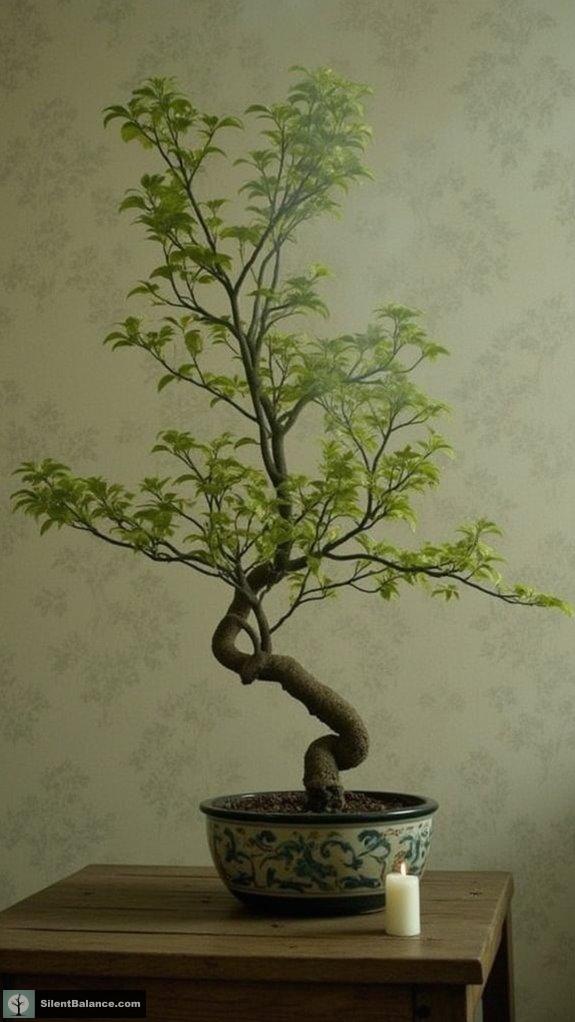
Bonsai isn’t just a tree; it’s a living snapshot of who you are!
When I shape a bonsai, I’m not just cultivating leaves; I’m crafting my cultural identity and personal expression. Each twist and turn reflects my heritage connection and commitment to environmental stewardship.
Isn’t it incredible how these little trees become an individuality statement?
Mindful cultivation transforms the mundane into an artistic representation of my journey, while serving as a creative outlet.
Plus, it allows me to join a community packed with insider lingo that only true bonsai enthusiasts get.
The Influence of Bonsai on Modern Design and Architecture
Crafting my bonsai is more than just a personal expression; it’s a gateway into how these miniature trees influence modern design and architecture.
Imagine the fusion of bonsai aesthetics with contemporary spaces. It’s inspiring!
- Modern minimalism: embraces simplicity and elegance, often echoing bonsai’s fine lines.
- Biophilic design: emphasizes nature integration, promoting well-being in urban environments.
- Interior settings: turn living spaces into tranquil retreats, reminiscent of expansive bonsai gardens.
Furthermore, the Japandi Scandinavian decor style highlights the harmony between natural elements and minimalism, making bonsai a perfect centerpiece.
Summary
In wrapping this up, bonsai cultivation is like a dance between nature and artistry, where every twist and turn tells a story. As you nurture your little tree, recall it symbolizes patience, dedication, and a deep respect for nature. So, whether you’re a seasoned pro or just starting, embrace the journey! Isn’t it amazing how a tiny tree can reflect such rich cultural heritage? Let’s continue exploring and sharing the bonsai magic together!
- 7 Statement Tree Panel Designs for Modern Spaces - October 1, 2025
- 15 Woodland Centerpiece Sculpture Tips For Fall - September 30, 2025
- 10 Sleek Wooden Relief Art Ideas - September 30, 2025

